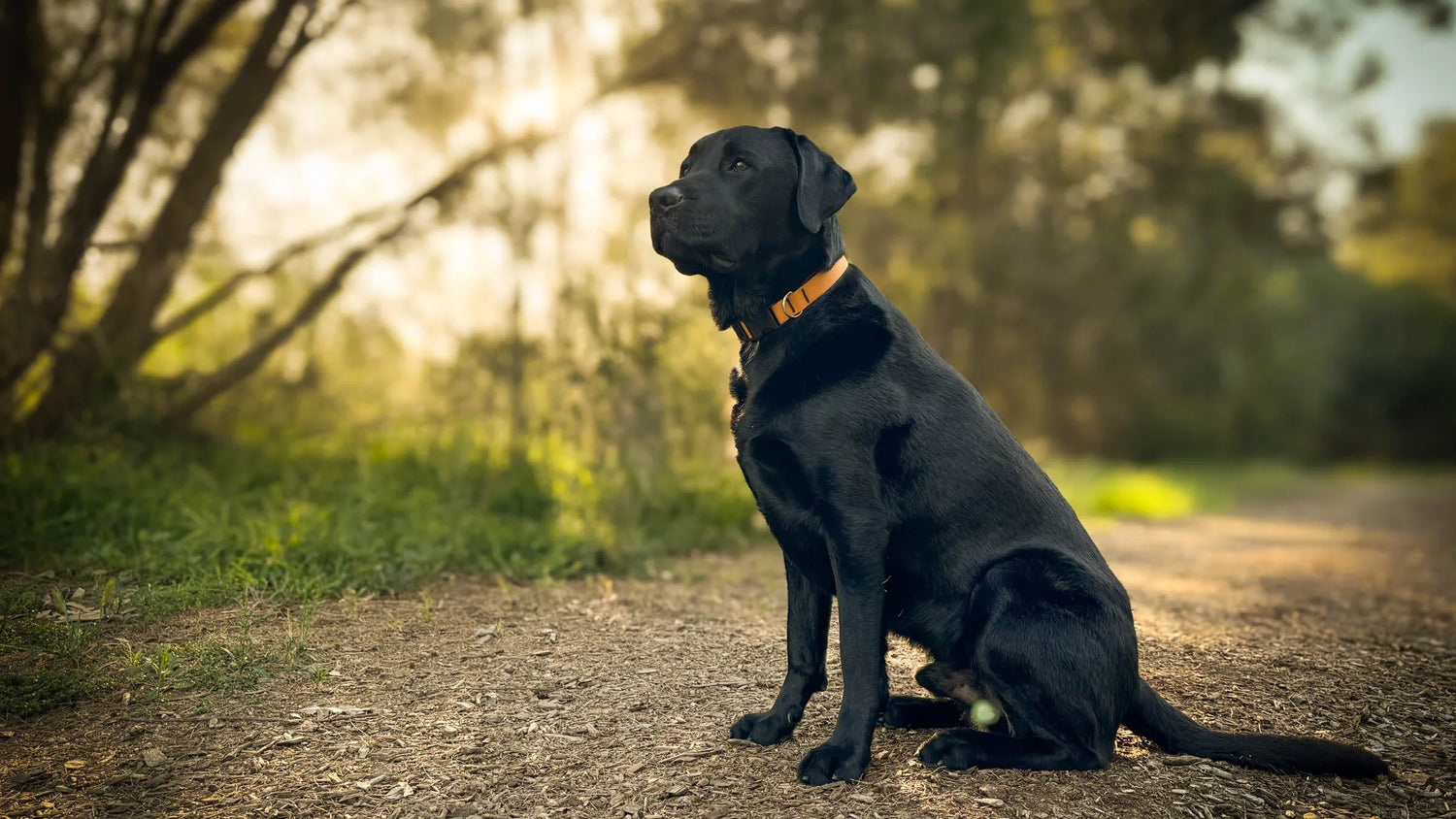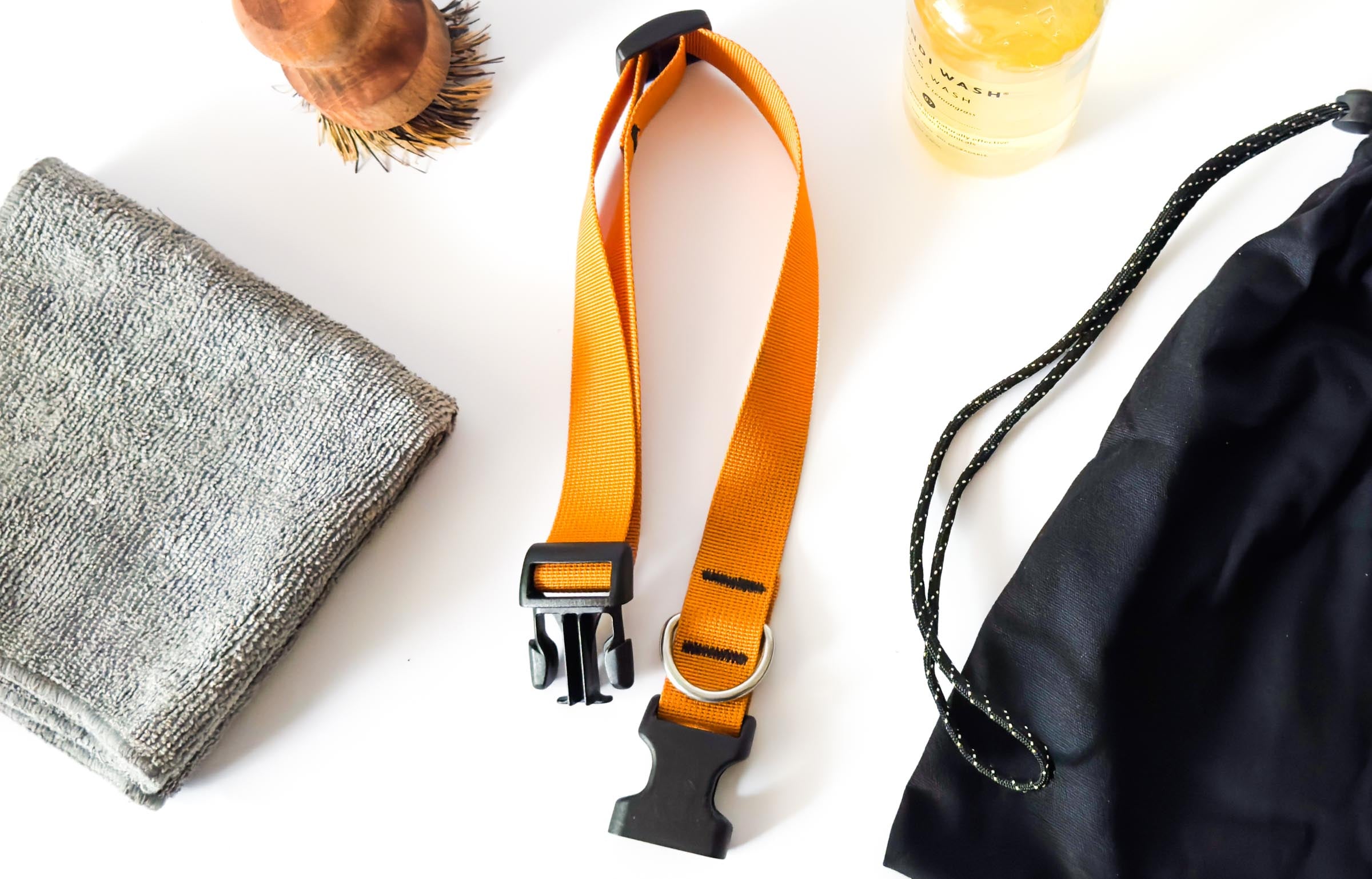Summary
- The key to a well-fitted dog collar is balancing security and comfort—too tight can cause breathing issues, while too loose means your dog could slip out or get caught on objects.
- The two-finger rule is a good starting point, but there is margin for error and it's often done incorrectly. Ensure you can rotate your fingers 90 degrees; otherwise, the collar is too tight.
- The buckle tuck is a foolproof method that involves tucking the female buckle under and then touching the male buckle to the collar material looped around the female buckle. This standardises the fit, adding a buffer for comfort, and scales with collar size.
- Collar placement matters: higher on the neck (for training) requires a snug fit, while lower on the neck (for everyday wear) can be looser to avoid irritation.
- If the collar is only used for ID tags and not leash attachment, it can be a bit looser for comfort and all-day wear.
- Long-haired dogs need extra care—check how the collar feels against the skin, not just the fur.
- Look for signs like coughing, fur loss, or irritation—these show the collar might be too tight.
- Regularly adjust your dog's collar as they grow, or if you notice fit changes over time.
- For training collars like martingales and head halters, use them temporarily and switch back to a regular collar or no collar when leash training or walking is done.
By tailoring the fit to its use and checking regularly, you’ll ensure your dog’s collar is both safe and comfortable.
Why Dog Collar Fit Is Critical

Fitting your dog’s collar isn’t just about making sure it looks right—it’s about your dog’s safety and well-being. If a collar is too tight, it can cause serious problems like restricted breathing, skin irritation, or fur loss. On the other hand, if it’s too loose, your dog could easily slip out during walks, or worse, get the collar caught on something.
When thinking about how tight a dog collar should be, aim for a balance. The collar should be snug enough to stay in place but loose enough to avoid discomfort.
Check the dog collar fit regularly, especially if your dog is growing or has thick fur that might hide how the collar is really sitting. A well-fitted collar keeps your dog comfortable and safe, without the risk of injury or escape.
The Two-Finger Rule
 The two-finger rule is probably the first thing you hear when it comes to collar fitting. It’s simple: you should be able to comfortably slide two fingers under the collar. While it’s a helpful starting point, the rule has its limits.
The two-finger rule is probably the first thing you hear when it comes to collar fitting. It’s simple: you should be able to comfortably slide two fingers under the collar. While it’s a helpful starting point, the rule has its limits.Finger sizes vary, so what works for you might be too tight or too loose for someone else. And when it comes to small dogs, two fingers could leave too much space, while for larger dogs, it might still be restrictive.
You can still use the two-finger rule as a starting point, but at least add a simple check: once you've slid two fingers under the collar, make sure you can rotate them 90 degrees. If you can’t, the collar is too tight
If your dog has thick fur, make sure to part the fur and test the tightness of the collar as close to their skin as possible.
It’s also important to check the collar when your dog is both standing and sitting, as posture can affect how tight the collar feels.
For a more precise fit, we recommend the buckle tuck method that removes subjectivity of 'snugness', the variance of finger sizes, and standardises fit across breeds.
The Buckle Tuck: Foolproof Method for Fitting a Dog Collar


This method provides a few key advantages:
- Standardised Buffer: Tucking the female buckle creates a small, consistent buffer between the collar and your dog’s neck, ensuring comfort.
- Accurate Fit: Touching the male buckle to the looped material mimics the actual connection, with a small additional buffer, since the male part will not reach quite as far once fastened.
- Scalable for Different Sizes: Since buckles are generally proportional to the collar size, this method adjusts naturally for different dog sizes without relying on finger size or breed.
This technique is a more precise alternative to the two-finger rule, offering a standardised approach that can be used across various collar sizes and breeds.
Dog Collar Placement Makes a Difference

Where the collar sits on your dog’s neck is just as important as how tight it is. A collar worn higher up, near the base of the jaw, can be slightly tighter because there’s less muscle and skin in that area, which allows for more control, especially with training collars. A lower collar, closer to the shoulders, should be looser to prevent chafing and irritation.
You’ll also notice that as your dog moves—whether sitting, standing, or sleeping—the position of the collar can shift. A snug collar might feel comfortable when your dog is standing but become too tight when they sit down. This is why it’s essential to assess the collar’s fit in multiple positions, adjusting as needed to ensure it stays comfortable throughout the day.
Different Uses, Different Fits
The tightness of a dog collar depends on how you’re using it. If your dog wears a collar to hold their ID tags and uses a harness, halter, or training collar for walks, their regular collar can be looser for comfort. But if you attach a leash directly to the collar, especially for dogs that tend to pull, you’ll want it a little tighter to give you more control.
For dogs that wear their collars all day, comfort should be your top priority. You don’t want the collar to constantly press against their neck, causing discomfort or irritation over time. In these cases, looser is better—just make sure the collar can’t easily slip off over their head. If the collar is only used during walks, a snugger fit is fine, but loosen it if it’s causing any discomfort.
Signs A Dog Collar Is Too Tight

It’s not always easy to tell when a dog collar is too tight, especially because dogs don’t always show discomfort immediately. But there are a few key signs to watch for. If your dog is coughing, gagging, or struggling to breathe, the collar may be pressing on their trachea. Visible irritation or fur loss around the neck is another red flag.
If your dog seems to be panting more than usual, or if they seem uncomfortable during walks, these could also be signs that the collar is too tight. In these cases, you’ll need to loosen it immediately. A properly fitted collar won’t cause any of these issues. It’s all about balance—enough tightness to prevent slipping, but enough slack to allow normal breathing and movement.
The Dangers of a Loose Dog Collar
A loose dog collar might seem like a minor issue, but it can quickly turn into a safety hazard. If the collar is too loose, your dog could slip out, especially on walks or during play. This puts them at risk of running off into traffic or getting lost without any form of identification.
Loose collars are more likely to get caught on objects like fences, furniture, or even other dogs during play. The looser the collar, the more likely dangling ID tags can catch on something and this could lead to choking, injuries, and other mishaps.
To avoid these risks, always make sure the collar is snug enough that it won’t slide over your dog’s head, but not so tight that it restricts movement.
Regularly check the collar’s fit, especially after your dog has been playing, pulling, or even just moving around. The collar should be snug enough to stay in place, but not so loose that it becomes a hazard.
Dog Collar Fit for Longer Haired Breeds
For breeds with longer fur or thicker coats, collar fitting can be tricky. Thick coats can make it seem like the collar is too tight when, in reality, it’s just compressing their fur. While fur imprints around the neck might look like a sign of tightness, they don’t always mean the collar is too tight.

The best way to ensure a good fit for long-haired dogs is to part the fur and feel how the collar sits closer to their skin. The collar should be snug but not digging into the skin. If you’re unsure, check for signs of irritation or discomfort, like your dog scratching at the collar or excessive shedding around the neck.
Remember, imprints on the fur aren’t always a problem—what you’re really looking for is how the collar feels closer to their skin and whether it’s causing any discomfort or irritation.
Training Dog Collars Need a Different Fit
Training collars, like martingales and head halters, are designed for added control during walks or training sessions, so they need to fit more securely than regular collars. These collars are typically positioned higher on the neck, near the jawline, to provide better leverage and prevent slipping.

However, these collars are intended for short-term use. Once the training or walk is over, it's important to switch back to a regular collar or remove the collar entirely for your dog's comfort and safety.
Conclusion
The right fit for a dog collar depends on several factors, and it’s important to get it just right for both safety and comfort.
While the two-finger rule has been a standard method, it has its limitations. If you do use it, ensure that your fingers can rotate 90 degrees to avoid an overly tight fit.
For a foolproof and consistent approach, the buckle tuck method offers a better solution.
Remember to consider your dog’s size and coat—thick fur might make a collar feel tighter than it is, so always feel the collar as close as possible to their skin.
Where the collar sits on your dog’s neck is also crucial. Higher up near the jaw, especially with training collars, you’ll want a snugger fit for control, but lower collars closer to the shoulders should be a bit looser to avoid irritation.
If the collar is only for holding ID tags and registration, you can afford to keep it looser, especially for all-day wear.
It’s essential to regularly adjust the collar as your dog grows or if you notice signs of discomfort, such as coughing or fur loss.
For training collars, like martingales or head halters, always switch back to a regular collar or remove the collar altogether after the session to give your dog some relief.
Ultimately, the tightness of a dog collar should be tailored to its use—whether it’s for leash control, identification, or training. Regular checks and adjustments ensure that your dog’s collar remains safe, secure, and comfortable at all times.



Leave a comment
This site is protected by hCaptcha and the hCaptcha Privacy Policy and Terms of Service apply.